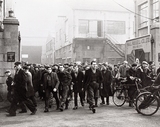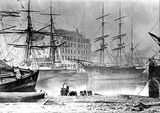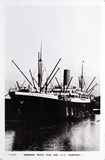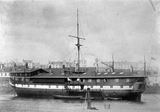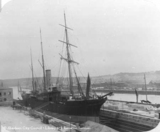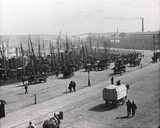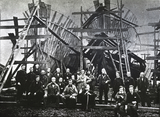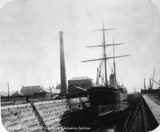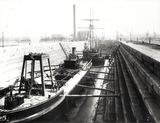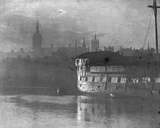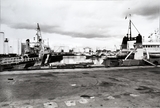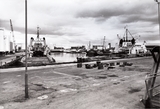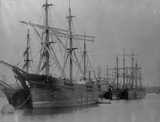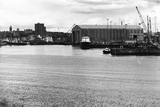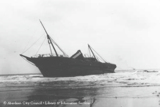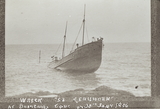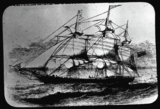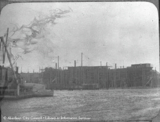|
Quick Search
|
Search Results
You searched for: Subject matches "Ships and Shipbuilding" or its children
113 items
items as
Hall Russell shipbuilders
6 Hall Russell, Ship Builders, Marine Place c. 1950s/60s. Note the main office is off to the right. The entrance at the top of the stairs is to the loft, where scale drawing and templates were drafted. The shipwrights department was on the ground floor to the south of this building.
[Many thanks to Stanley Bruce for providing us with correct details on the building layout.] Upper Dock
52 A photograph showing many large sailing ships in the Upper Dock of Aberdeen Harbour. This image looks north west towards the junction of Market and Guild Street from Regent Road (near the start of Blaikie's Quay).
The prominent granite building in the background was at the corner of this junction at 62-68 Market Street. It was a warehouse and offices with shops on the ground floor. The site was redeveloped for the office blocks that can be seen today in around the early 1980s. This block may have been demolished at that time.
Prior to the late 19th century continuing development of Market Street and the creation of Provost Jamieson's Quay, the south side of the Upper Dock was the site of various ship building yards, with timber yards behind.
The ship shown in front of the building is the City of Aberdeen. It was built in 1862 by John Duthie, Sons & Co. for the China trade. It was altered to barque rigging in 1877 and this be the period of this photograph. The ship has an entry on the Aberdeen Built Ships website here. HMS Clyde in Aberdeen Harbour
278 HMS Clyde in Aberdeen Harbour. She was a training vessel for the Royal Naval Reserve and was moored in the Upper Dock before being scrapped. Dry Dock, Albert Basin
334 A large dry dock was built in the Albert Basin in 1885 for the repair and overhaul of ships. It was demolished in 1924-27 to make way for the covered fish market. Market Street and Albert Quay
339 A photograph of Aberdeen Harbour. The image likely dates from some time in the late 19th century.
The photograph was taken at the junction of Lower Market Street and Albert Quay, before the extension of the covered fishmarket along this stretch to the pontoon docks on the quay.
See this photograph taken slightly north showing the upper part of Albert Basin and the covered fish market then on Commercial Road. The Fairweather
348 The Fairweather paddle steam tugboat towing a sailing ship out of Aberdeen Harbour.
The Fairweather was built by Richard Stobbs, North Sheilds, in 1871 and was wrecked in the entrance to Aberdeen Harbour in 1912.
The Tyne Tugs and Tug Builders website gives further information on the boat here. The shipyard of Alexander Hall and Company
349 The ship yard of Alexander Hall and Company. Two ships under construction. c.1862 Dry Dock in Albert Basin
360 A large dry dock for the repair and overhauling of ships was opened at the eastern end of the Albert Basin in 1885. It was demolished in 1924-27 to make way for the covered fish market. The Dry Dock at Albert Basin
466 The Dry Dock for the repair and overhauling of steamships was opened at the eastern end of the Albert Basin in 1885. It was demolished in 1924-27 to make way for an extension of the covered fish market. Aberdeen Harbour with HMS Clyde
503 HMS Clyde at Aberdeen harbour. HMS Clyde was a man o' war with 46 guns and 1081 tons. The ship was for a long time moored in the Upper Dock where it served as a training ship. Connected to the quay by a floating gangway, the ship was open to visitors on Sunday mornings. After being shifted to Albert Quay it was towed away to be scrapped. Maitland's Quay
608 A photograph looking north from Maitland's Quay, off Sinclair Road, into the River Dee Dock, also known as the Torry Dock.
Supply boats are moored in the dock and mud silos are visible on the left of the image, next to the site of John Lewis & Sons' shipyard.
Beyond the dock, across the River Dee, oil tanks can be seen on Point Law and the shipyard of Hall Russell can be seen in the far distance.
This image was likely taken in the 1980s. Maitland's Quay
613 A photograph looking north east from Maitland's Quay, off Sinclair Road, into the River Dee Dock, also known as the Torry Dock.
Supply boats are moored in the dock and mud silos are visible on the left of the image, next to the site of John Lewis & Sons' shipyard.
Beyond the dock, across the River Dee, oil tanks can be seen on Point Law.
This image was likely taken in the 1980s. Sailing ships
633 A photograph showing large sailing ships in Aberdeen Harbour. St. Clement's Church can be seen in the background on the left. This suggests the ships are in Victoria Dock. HMS Clyde
830 A postcard image showing the Naval Reserve training ship, HMS Clyde, in Aberdeen Harbour's Victoria Dock. The spire of the Town House can be seen on the skyline. Hall Russells shipbuilding yard
1256 A photograph, taken in around 1983, looking north west towards Hall Russells shipbuilding yard on York Place. The image was likely taken from Balnagask and shows the Tidal Harbour. Note the small pilot cutter in the foreground. Home from the Herring Harvest
1800 An image entitled Home from the Herring Harvest. It shows the paddle steam tugboat John McConnachie (built 1879) towing a large number of scaffie fishing vessels into Aberdeen Harbour. The south breakwater can be seen in the background.
Steam tugboats were greatly useful for the safe and orderly navigation of the harbour by sailing ships. They were also employed in rescue and salvage operations and for the launching of boats. Town and harbour of Aberdeen
1803 An illustrated view of the town and harbour of Aberdeen, from Balnagask in the south, showing sailing ships on the River Dee.
This illustration looks like a variation on John Slezer's 'New Aberdene from the Block house' from Theatrum Scotiae of 1693. SS James Hall
1937 The wreck of the steamship "James Hall".
On Tuesday 23rd February 1904, the steamer James Hall, belonging to the Aberdeen, Leith and Moray Firth Steam Shipping Company Ltd, and the Luddick, belonging to the Aberdeen, Newcastle and Hull Steam Company Ltd, collided in Aberdeen Bay.
The crew of the James Hall were rescued by the Luddick and the former was left to drift ashore on the beach. The damaged Luddick successfully steamed into harbour.
There was a large hole about 17 feet long in the James Hall, but it was thought possible to temporarily repair the damage and refloat the ship. For the next few days, the local press reported that crowds of people had been to see the wreck, and that two trams with posters saying 'To and from the stranded steamer' were put on the Beach route.
Unfortunately, owing to strong winds and heavy seas, salvage attempts were not possible, and the vessel began to break up and its cargo was washed ashore. By the 8th March, very little remained of the wreck. SS James Hall
1938 The wreck of the steam ship the 'James Hall'. It drifted ashore after colliding with another called the 'Luddick' on 23rd February 1904. |



